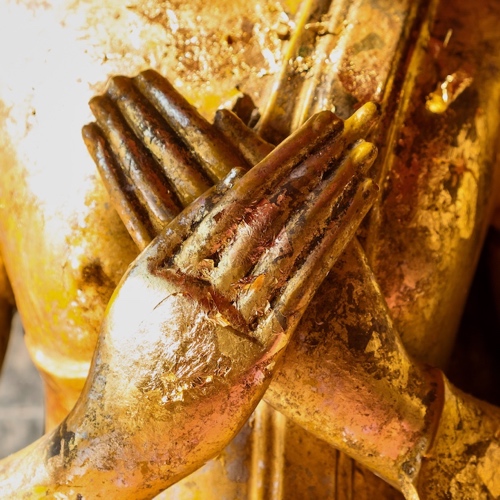If you’re new to Kundalini Global you may wonder what makes it different from other forms of yoga you have encountered, or be curious about what to expect in a class.
To give you a taster we have put together a list of 9 facts about Kundalini Global that you may not know.
1. Everyone who teaches Kundalini Global opens their classes with the same stretch.
This is not about our practise being prescriptive but about recognising, as a collective, how important it is that every single person in a class can start from a place of presence.
And the stretch? It really works.

This Kundalini Global opening stretch is about resetting the stress system and landing into the body. It is simple. Accessible. And, once learned, can be used as a tool any time, any place, when you notice you don’t like how you feel and would like change.
2. We do not subscribe to a guru system
Kundalini Global teachers are self-initiated. We are tasked, throughout our training and beyond, to shed (or, at the least, deeply examine) our ‘cult thought,’ be ourselves, and bring our humanity into how we approach the role of being a yoga teacher.
3. We adore the pauses (no matter how much you don’t!)
If you come to a KG class for the first time, you may be surprised by, or even uncomfortable in, what are most often 1-2 minute pauses between postures.
Whilst we won’t go deeply into the ‘why’ now… the pauses are important. Really important. Play with the invitations made by teachers to check in with how you’ve made yourself feel. Notice if you can stay in the pauses with the eyes closed.
4. Lots of us talk about hormones…
It is commented on often, from those who come to classes for the first time, that they enjoy, but are not used to, learning about hormones and neurotransmitters* in yoga classes.
KG teachers are quite likely to mention them often.
This is because understanding how posture and breath relate to changing hormonal flow is a core aspect of how we are trained to work with the stress system. For many teachers it becomes a fascination. It is an aspect of what we do that is very well received.
*Neurotransmitters and hormones are different types of chemicals that carry signals in the body. Hormones are made in your endocrine glands and the neurotransmitters by your nervous system. Some neurotransmitters, like dopamine and serotonin, have hormonal functions… much recent research suggests that many hormones work as neurotransmitters and many neurotransmitters as hormones, so it’s an interesting topic to stay up to date on, if you’re so inclined…
5. We like to go slow…
People who have practised Kundalini Yoga in other forms are sometimes surprised by how slowly we tend to move. Particularly when it comes to postures they are familiar with such as Spinal Flex or Spinal Twists.
This is a conscious choice born of an understanding of the physiological and psychological impact of slow, mindful, considered, movement, where we can explore the sensations of the body as we move.
It often allows for a more embodied practise to emerge for the practitioner.
6. We play all kinds of music
Teachers may play any kind of music. We aim to be inclusive and respectful of all religious and spiritual belief systems and to open up the possibilities of what could come into a yoga class relative not only to music, but also when we look to mantra… to prayer…
Because we are invited to think for ourselves, this could mean all kinds of things. You may love the music in one teacher’s classes and despise it in another, and that’s fine! You can explore the teachers to find whose approach lands with you. Teachers have been known to use everything from Britney Spears to Gregorian Chanting.
7. We are kind with the times spent ‘doing’
When postures are particularly challenging, we limit the time they are practised for. We will limit, for example, the time in a plank to a minute. We expect no one to be super human. In fact, we hope all feel safe enough to be nothing but extremely human and to notice how potent a kinder, softer, approach to the self can be.
8. We don’t need to tell you how to relax
How you take your relaxation in a Kundalini Global class is not a prescriptive exercise. The relaxation at the end of a class is about you being as soft, as still, as gentle… as you can possibly be in the moment. However that manifests for you is cool with us. Lie back, curl up, sit in a chair… the choice is entirely yours.
9. We see our practise as sacred
Kundalini Global is a new form of yoga, and at its core is an understanding of how practises such as stretching, consciously breathing, prayer… can offer positive, transformational, experiences in this time, for all human beings. That is not, in any way, to say that Kundalini Global does not educate teachers in and have huge respect for yoga’s roots.
All teachers understand and hold awareness of the sacred aspect of our practise. For us, what we do, what we show up for, what we are in service to offer, goes very far beyond the ‘poses’.
We believe that everyone can have a very profound and deep experience of their relationship to the Divine, in whatever form they believe it to take, by finding immanence within themselves.
We bow, with love, respect, and gratitude, to the Divine, at the opening and closing of every class. This is the container, the Quantum Field, within which the entirety of what we offer in our classes is held.
Ready to give it a go?
Any one of our teachers would be thrilled to guide you through a class.
You can find some of our teachers listed here (and lots more coming soon!)

